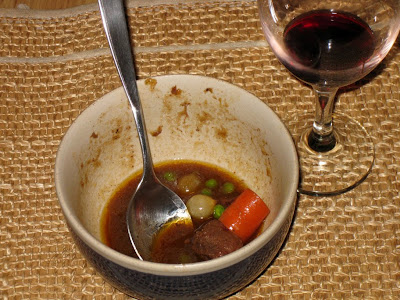 |
| Complaining about the weather is like complaining about taxes. When you're finished grousing, both are still there. But really, negative wind chill temps? No thanks. These days, I'm online a good part of the morning looking for jobs in California. There, the winters are insanely harsh. One wears long-sleeve tee shirts, or maybe a hoody on the coldest mornings. Buried deep in a box somewhere is a photo of me and my friends, two pictures actually. In the first we're holding up a newspaper in the local mountains where we skied that morning. In the second, we're holding up that same newspaper later the same day at the beach where we planned to surf. That's what I call winter. |
| |
| Ah, those were Halcyon days. Now, I cope with two pairs of socks, long johns, and fleece. And stew of course. |
| |
| Classic Beef Stew - As told by Blog O. Food |
- ¼ cup extra virgin olive oil
- 2 Tbsp butter
- 2 lbs beef chuck shoulder, cut into 2" pieces
- 3 cloves garlic, crushed
- 1 medium yellow onion, halved and sliced
- 2½ cups beef stock
- 1 Tbsp Worcestershire sauce
- 2 bay leaves
- 1 tsp salt
- 1 tsp sugar
- ½ tsp pepper
- ½ tsp paprika
- Pinch ground allspice or ground clove
- 6 new potatoes, quartered
- 3 large carrots, roughly chopped
- 1 cup frozen pearl onions
- ½ lb button mushrooms, quartered
- ½ cup frozen peas
- Flat-leaf parsley, for garnish
|
  |
  |
  |
| Preheat a large Dutch oven or heavy-bottomed stock pot over medium-high heat with the oil and butter. |
| While the pan is heating, pat dry the cubed beef (moist meat will not brown properly). When the butter has melted and the oil is hot, brown the beef in batches. Do not over crowd the pan. Remove and reserve browned meat. |
| Add onions to the pan and cook to soften, scraping the bottom of your Dutch oven with a wooden spoon to remove the caramelized bits. Return the meat to the pot. Add beef stock, Worcestershire sauce, bay leaves and all the spices and sugar to the pot, and stir to combine. Cover and simmer for 90 minutes. |
| Remove the bay leaves add the potatoes, carrots and pearl onions, raise the heat a bit, partially cover the pot and cook for another 20 minutes. |
| Add the mushrooms and cook and additional 10 minutes. |
| Finally, add the peas and cook for 2 minutes longer. |
| After adding peas to the stew, toast rustic Italian or French bread. |
| Ladle stew into bowls, garnish with parsley and serve with bread on the side. |
| |
 |
| |
| Slow cooking like this is all about building layers of flavor. Browning the meat first builds a base with caramelized sugars. Sweating onions and deglazing intensifies that first layer. Braising allows the meat to tenderize and release more beef flavor into the broth. Finally, vegetables add subtle complexities all their own. Imagine if you just threw everything into a pot all at once and walked away for a couple hours. Try it sometime and let me know how that works out for you. In any event, my stew filled the house with the most incredible and comforting odors. I walked down to the lobby at one point. Re-entering the apartment, I took several slow deep breaths identifying each and every characteristic of the smell. I even cradled the bowl in my hands while I ate. Wouldn't I make a great stew spokesperson! |
| |
| My Chebeague sister Muffy is swapping house sitting/plant watering duties with me, for a friend out on Long Island. (He winters in Miami Beach!!!) I made this stew with her in mind. I plan on surprising her with Julia Child's Boeuf à la Bourguignonne. If that doesn't warm her heart, it's off to the emergency room for an EKG. |
| |
 |
| |
| |
| Thanks for taking the time - Blog O. Food |
| |
| |
1 comment:
Did the stew for Sunday dinner. It was good... even though SD is suffering through 75 degree afternoons... I tried to imagine the weather being cold while we slurped up the beefy bowls of goodness.
There was enough for leftovers this week.
I added celery and used brown sugar, but everything else was from your recipe.
I give this 5 out of 5 Belches using the standard Belch-o-meter ranking methodology.
Post a Comment